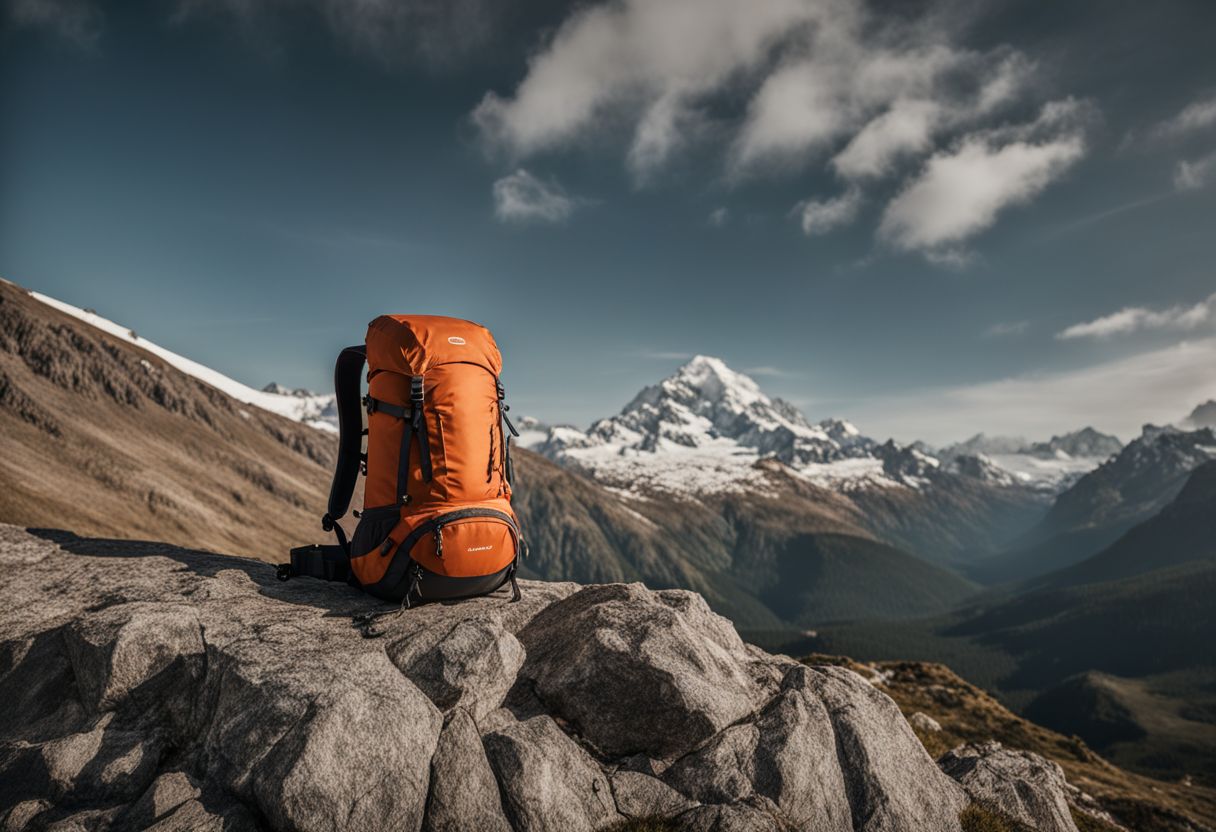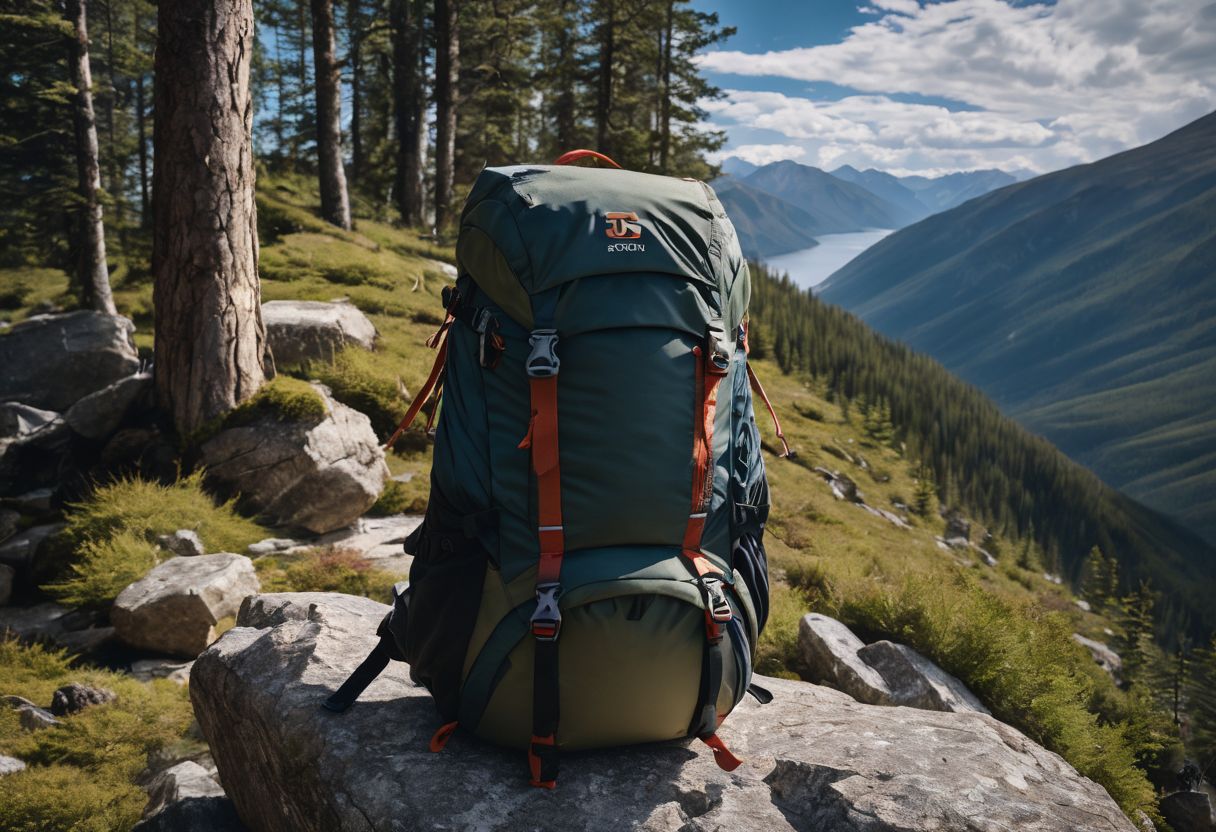Ripstop fabric isn’t just another material; it’s the unsung hero that adventurers trust to keep their gear in one piece. As a seasoned outdoor enthusiast with years of experience testing the bounds of camping gear, I have witnessed firsthand how ripstop rucksacks withstand nature’s unforgiving elements.
Crafted to outlast rough terrains and unexpected snags, ripstop nylon revolutionized backpack durability by introducing a gridwork of thicker threads woven into lighter fabric. This innovation means carrying your essentials without constantly worrying about wear and tear.
Understanding this textile marvel is crucial for choosing equipment that matches the rigor of your ventures. A ripstop rucksack isn’t merely an accessory; it’s a reliable companion on every trail you blaze.
Let’s unravel why its exceptional properties make it integral to high-quality outdoor gear – reinforcing not just fabric but confidence in your journey ahead. Continue reading, and let’s explore how these resilient fibers can elevate your adventure game!
Key Takeaways
- Ripstop fabric is a strong and durable material used in rucksacks, offering exceptional resistance to tears and abrasions due to its unique grid pattern weave.
- Rucksacks made with ripstop fabric are lightweight, water – resistant, and designed for various outdoor activities such as hiking, camping, and travel.
- Proper care and maintenance of ripstop fabric rucksacks include hand washing with mild detergent, air drying, avoiding harsh chemicals, repairing tears promptly, protecting from UV degradation, and following manufacturer’s guidelines.
What is Ripstop Fabric?

Ripstop fabric is a durable woven material that is designed to resist tearing and ripping. It is often made from nylon, polyester, or other synthetic materials and has a unique grid pattern with thicker threads woven in at regular intervals to provide reinforcement.
Ripstop fabric has a long history of use in various applications such as military gear, outdoor equipment, tents, sails, and even motorcycle jackets.
Definition and history
Ripstop fabric is a strong material made with a special weaving technique that includes a grid of thick threads. This creates a pattern of small squares on the fabric’s surface which helps stop tears from spreading.
It’s like having built-in reinforcement. People first started making ripstop during World War II because they needed tough, reliable cloth for parachutes.
The history shows how important this fabric has been for safety and survival. Parachute makers looked for ways to make sure their silk fabrics wouldn’t rip easily when soldiers used them in the sky.
By adding strong threads in a crosshatch pattern, they created the first version of what we now call ripstop fabric. Since then, it has become very popular in all sorts of things people use every day, not just parachutes!
Properties of ripstop fabric
Ripstop fabric is a strong and durable material used in many outdoor items. It’s unique because it has special threads woven into it.
- Strong threads: The fabric gets its toughness from thick threads woven in a grid. These threads keep small tears from getting bigger.
- Not heavy: Even though it’s strong, this fabric is light. That means things made with it won’t weigh you down.
- Tough against rips: The way the threads are woven makes the fabric hard to tear. If you get a small cut in your bag, it probably won’t tear more.
- Smooth and fine texture: Ripstop feels smooth to touch, which makes bags look nice and feel good.
- Resists water: Water doesn’t soak into ripstop easily. So things inside a bag made of ripstop might stay dry if it rains.
- Breathes well: You don’t want your bag to get all sweaty on the back. Ripstop lets air move through so that less sweat sticks around.
Common uses
Ripstop fabric is tough stuff. It’s the go-to material for making rugged, ready-for-anything rucksacks that hikers and campers love. Not just for the trails, this fabric is also a key player in military gear and firefighter suits.
Its knack for not ripping easily makes it perfect for these high-stress jobs where tough wear is expected. In backpacks, ripstop means you can pack your things without worrying about tears or damage from sharp rocks or branches.
On top of being strong, ripstop fabrics are light and often fight off water well. This keeps your gear dry and easy to carry on any adventure. Brands use different kinds like rip-stop nylon or laminates with ballistics nylon to give their bags a boost in strength while keeping them super portable.
These bags aren’t just about carrying stuff; they’re about doing it without weighing you down or falling apart when you need them most.
Advantages of Ripstop Fabric in Rucksacks

Ripstop fabric offers durability, resistance to tears and abrasions, and is lightweight and water-resistant, making it an ideal choice for rucksacks.
Durability and strength
Ripstop fabric is widely recognized for its outstanding durability and strength, making it a top choice for rucksack construction. Its high-performance material ensures that rucksacks can withstand tough outdoor conditions, providing reliability for extended use during various activities.
The special reinforcement technology used in ripstop fabric enhances its tear-resistant properties, ensuring that the rucksack remains intact even under challenging circumstances.
Additionally, ripstop fabric contributes to the overall longevity of the rucksack by preventing small tears from expanding into larger ones. This feature further solidifies the fabric’s position as a crucial element in creating robust and long-lasting rucksacks essential for outdoor adventures.
Resistance to tears and abrasions
Ripstop fabric stands out for its exceptional resistance to tears and abrasions, making it highly durable and reliable for use in rucksacks. This is attributed to its unique grid pattern weave, which reinforces the fabric and prevents small tears from spreading.
The high tensile strength of ripstop fabric, achieved through the use of synthetic fibers such as ultra-high-molecular-weight polyethylene (UHMWPE) or nylon, further enhances its ability to withstand wear and tear over time.
Additionally, the density of ripstop fabrics contributes to their ability to resist punctures and abrasions, ensuring that rucksacks made with this material can endure rugged outdoor activities without compromising their integrity.
The remarkable resistance of ripstop fabric makes it an ideal choice for rucksacks used in diverse environments where durability is crucial. Its capacity to withstand tears and abrasions ensures that users can rely on their rucksacks even in challenging conditions without having to worry about frequent repairs or replacements.
Lightweight and water-resistant
Ripstop fabric is an ideal choice for rucksacks and backpacks due to its lightweight nature. This makes the rucksack easier to carry, especially during long outdoor treks or travels.
Additionally, ripstop fabric being water-resistant provides protection against unexpected rain showers or wet conditions, keeping your belongings safe and dry while on the go.
The combination of these two factors – lightweight and water-resistance – make ripstop fabric a practical and functional choice for outdoor enthusiasts seeking durable yet convenient gear for their adventures.
How is Ripstop Fabric Used in Rucksacks?
Ripstop fabric is commonly used in rucksacks to provide durability and strength, making them ideal for outdoor activities. To learn more about the specific features and design elements of ripstop rucksacks, keep reading below.
Types of rucksacks made with ripstop fabric
Rucksacks made with ripstop fabric come in various designs and styles to cater to different activities and preferences:
- Daypacks: Compact and lightweight, suitable for day hikes, commuting, or travel.
- Tactical Rucksacks: Designed with additional compartments and MOLLE webbing for military or outdoor use.
- Travel Backpacks: Equipped with multiple pockets, padded straps, and laptop compartments for urban and adventure travel.
- Hydration Packs: Featuring a water reservoir and tube for hands-free hydration during hiking, cycling, or running.
- Overnight Backpacks: Larger capacity with multiple compartments for weekend camping trips or short travels.
Features and design elements
Ripstop fabric rucksacks are engineered with specific features and design elements to enhance their functionality and durability.
- Large Compartment and Wide Front Pocket: Ripstop fabric rucksacks typically feature a spacious main compartment, providing ample storage space for various essentials. Additionally, they often include a wide front pocket, allowing for convenient access to frequently used items.
- Adjustable Straps with Drawcord Fastening: The adjustable straps on ripstop rucksacks serve not only to customize the fit but also function as a drawcord fastening mechanism, enhancing security and durability during use.
- Reinforced Weave Pattern: The reinforced weave pattern of ripstop fabric enhances strength and sturdiness, ensuring that the rucksack can withstand rigorous outdoor activities without succumbing to tears or damage.
- Resistance to Tearing and Ripping: Due to the tear-resistant nature of ripstop fabric, rucksacks made from this material offer exceptional resistance to tearing and ripping, making them ideal for outdoor adventures and travel.
- Lightweight Construction: Ripstop fabric rucksacks are designed to be lightweight, providing added comfort during extended wear while also being easy to carry when fully packed.
- Water-Resistant Properties: Many ripstop fabric rucksacks boast water-resistant capabilities, safeguarding belongings from moisture in unpredictable weather conditions or outdoor environments.
- Enhanced Durability for Outdoor Use: The rugged reliability of ripstop nylon makes it a popular choice for outdoor gear, ensuring that the rucksack can withstand demanding environments and activities.
Care and maintenance
Ripstop fabric requires proper maintenance and care to extend the life of gear and ensure optimal performance. It is not advised to use machine cleaning for gear made with ripstop fabric, as the best way to clean gear with this fabric is through alternative methods. Here are some tips to effectively care for and maintain ripstop fabric in rucksacks:
- Hand wash with mild detergent: Gently hand wash the rucksack using a mild detergent to remove dirt, grime, and stains without causing damage to the fabric.
- Air dry: After washing, allow the rucksack to air dry completely in a well-ventilated area. Avoid using a dryer or exposing it directly to sunlight for extended periods to prevent potential damage.
- Avoid harsh chemicals: Refrain from using harsh chemicals, bleach, or strong cleaning agents that can degrade the integrity of the ripstop fabric.
- Repair promptly: Address any small tears or abrasions promptly by patching them up using compatible materials designed for ripstop fabric repairs.
- Protect from UV degradation: Store rucksacks away from direct sunlight when not in use to prevent UV degradation of the ripstop fabric.
- Check manufacturer’s guidelines: Refer to the manufacturer’s guidelines for specific care instructions tailored to the type of ripstop fabric used in the rucksack.
Choosing the Right Ripstop Rucksack
Considerations for different activities include outdoor durability, capacity, and comfort. Other factors to consider are the brand reputation, customer reviews, and specific features tailored to your needs.
Popular brands like Osprey and Patagonia offer a wide range of options in the market.
Considerations for different activities
When selecting a ripstop rucksack, it is important to consider the specific activities for which it will be used. Here are some factors to keep in mind:
- Outdoor Hiking and Camping:
- Look for a rucksack with ample space for carrying camping gear and provisions.
- Consider the need for external attachment points to carry items like tents, sleeping bags, or walking poles.
- Ensure the backpack offers comfort and support for long hikes.
- Travel and Commuting:
- Opt for a more compact rucksack with compartments suitable for organizing electronics, documents, and personal items.
- Look for features that provide easy access to essentials like water bottles or snacks while on the move.
- Consider durability and security features when navigating busy urban environments.
- Adventure Sports and Extreme Activities:
- Prioritize lightweight yet durable rucksacks with specialized attachment points for sports equipment like climbing gear or cycling accessories.
- Seek waterproofing and weather – resistant properties to protect belongings during outdoor pursuits.
- Look for ergonomic design elements that support movement during high – intensity activities.
- Everyday Use and School/Work:
- Choose a versatile rucksack suitable for everyday needs, such as carrying books, laptops, or gym clothes.
- Look for padded straps and back support if carrying heavy items regularly.
- Consider style preferences if using the backpack as a fashion accessory or work accessory.
Other factors to consider
When choosing a ripstop rucksack, it’s important to consider:
- Fiber type: Different fibers offer varying levels of durability, weight, and water resistance. Dyneema and Spectra are examples of high-performance fibers used in ripstop fabrics.
- Weave pattern: The pattern of weaving affects the strength and tear resistance of the fabric. Look for tight weaves such as ballistic nylon for enhanced durability.
- Weave density: A higher thread count or weave density generally results in a stronger fabric with better resistance to tears and abrasions.
- Material coating: Coatings like polyurethane or PVC enhance the water resistance of ripstop fabric, making it suitable for outdoor activities in various weather conditions.
- Size and capacity: Choose a rucksack that comfortably accommodates your gear without being excessively large, ensuring practicality and comfort during use.
Popular brands and options in the market
The marketplace offers a spectrum of reputable brands renowned for their high-quality ripstop rucksacks, each with distinctive features tailored to meet the needs of adventurers and urban travelers alike. Brands like Osprey, The North Face, and Patagonia stand out for their commitment to durability and sustainability, often incorporating Cordura nylon into their designs. These brands not only prioritize the longevity of their products but also increasingly focus on eco-friendly materials and production processes.
| Brand | Model | Key Features | Material | Eco-Friendly Options |
|---|---|---|---|---|
| Osprey | Atmos AG | Anti-Gravity suspension, adjustable harness, seamless mesh | Ripstop nylon, Cordura | Recycled materials, PFC-free DWR |
| The North Face | Surge | Fleece-lined laptop sleeve, reflective bike-light loop | Ripstop nylon, ballistic nylon | Recycled materials used |
| Patagonia | Black Hole | Weather-resistant, spacious main compartment | Ripstop polyester (with TPU-film laminate) | 100% recycled body fabric, lining, and webbing |
| Deuter | Speed Lite | Lightweight, Delrin U-frame, multiple storage options | Ripstop nylon | Green Shape label for sustainable products |
| Gregory | Baltoro | 3D AIR hip belt and shoulder harness, pre-curved components | Ripstop nylon, Cordura | Eco-conscious design choices |
This table serves as a navigational guide to a selection of highly esteemed brands and their standout rucksack models that integrate ripstop fabric, highlighting the balance between innovative features, the use of premium materials, and a nod to environmental responsibility.
Conclusion
In conclusion, ripstop fabric offers unmatched durability and strength, making it a top choice for rucksacks and outdoor gear. Its resistance to tears and abrasions ensures longevity in rough outdoor conditions.
When choosing a ripstop rucksack, consider your specific activities and the practical benefits you seek. With its lightweight, water-resistant properties, a ripstop rucksack can be your reliable companion for any adventure.
Choose wisely and embark on your next outdoor journey with confidence in the reliability of ripstop fabric.
FAQs
1. What is ripstop fabric in rucksacks?
Ripstop fabric is a strong material used in making backpacks. It has a special weave that stops tears from getting bigger.
2. Why do people use ripstop fabric for rucksacks?
People use ripstop for backpacks because it’s tough like body armor and doesn’t tear easily, which makes the backpack last longer.
3. Can ripstop fabric be made from different materials?
Yes, ripstop can be made from various materials like poly-propylene or ultra-high molecular weight polyethylene (UHMWPE), which are both very strong.
4. Is ripstop only good for making backpacks?
No, besides backpacks, ripstop works well for making other things too, like hot air balloons and ropes because it’s so durable.
5. How does thermoplastic play a role in ripstop fabrics?
Thermoplastic polymers like thermoplastic polyurethane can make the fabric even stronger when they’re combined with the fibrous threads used to weave them together.

